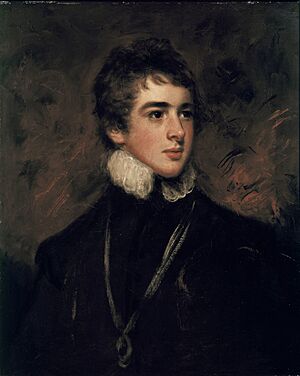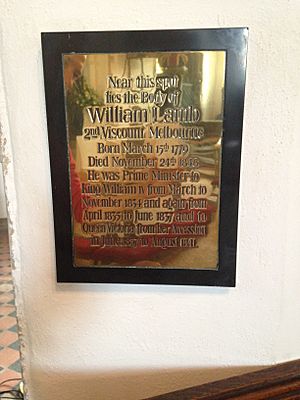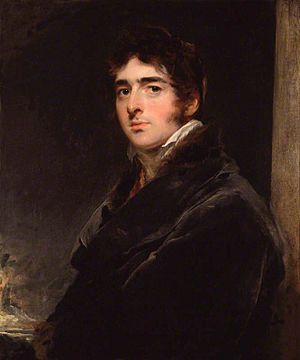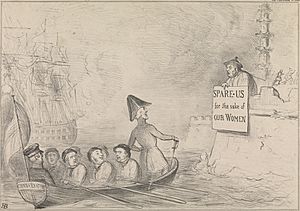William Lamb, 2nd Viscount Melbourne facts for kids
Quick facts for kids
The Viscount Melbourne
|
|
|---|---|

Portrait by John Partridge c. 1840
|
|
| Prime Minister of the United Kingdom | |
| In office 18 April 1835 – 30 August 1841 |
|
| Monarch | |
| Preceded by | Robert Peel |
| Succeeded by | Robert Peel |
| In office 16 July 1834 – 14 November 1834 |
|
| Monarch | William IV |
| Preceded by | The Earl Grey |
| Succeeded by | The Duke of Wellington |
| Leader of the Opposition | |
| In office 30 August 1841 – October 1842 |
|
| Preceded by | Robert Peel |
| Succeeded by | Lord John Russell |
| In office 14 November 1834 – 18 April 1835 |
|
| Preceded by | The Duke of Wellington |
| Succeeded by | Robert Peel |
| Leader of the House of Lords | |
| In office 18 April 1835 – 30 August 1841 |
|
| Preceded by | The Duke of Wellington |
| Succeeded by | The Duke of Wellington |
| In office 16 July 1834 – 14 November 1834 |
|
| Preceded by | The Earl Grey |
| Succeeded by | The Duke of Wellington |
| Home Secretary | |
| In office 22 November 1830 – 16 July 1834 |
|
| Preceded by | Robert Peel |
| Succeeded by | The Viscount Duncannon |
| Chief Secretary for Ireland | |
| In office 29 April 1827 – 21 June 1828 |
|
| Preceded by | Henry Goulburn |
| Succeeded by | Lord Francis Leveson-Gower |
| Personal details | |
| Born | 15 March 1779 London, England |
| Died | 24 November 1848 (aged 69) Brocket Hall, Hertfordshire, England |
| Resting place | St Etheldreda's Church, Hatfield |
| Political party | Whig |
| Spouse | |
| Children | 2 |
| Parents | |
| Education | Eton College |
| Alma mater | |
| Signature | |
William Lamb, 2nd Viscount Melbourne (born March 15, 1779 – died November 24, 1848) was a British politician. He was a member of the Whig party. He served as the Home Secretary and was also the Prime Minister of the United Kingdom twice.
His first time as Prime Minister ended in 1834 when William IV removed him from office. He was the last British prime minister to be dismissed by a king or queen. Five months later, he became Prime Minister again. He served for six more years, continuing into the reign of Queen Victoria. He is well-known for helping Queen Victoria learn about politics. He was almost like a private tutor for her.
Contents
Early Life and Education
William Lamb was born in London in 1779. He came from a wealthy Whig family. His parents were Penistone and Elizabeth Lamb.

He went to Eton College for his schooling. Then he studied at Trinity College, Cambridge and the University of Glasgow. He became a lawyer in 1804.
During the Napoleonic Wars, Lamb served as a Captain and later a Major in the Hertfordshire Volunteer Infantry. In 1805, he became the heir to his father's title after his older brother passed away. He married Lady Caroline Ponsonby in 1805. They later separated in 1825. They had a son named George Augustus Frederick, who died in 1836.
In 1806, Lamb was elected to the British House of Commons. He represented different areas as a Whig Member of Parliament (MP).
Becoming a Politician
Member of Parliament
In 1816, Lamb became an MP for Peterborough. He believed in the main ideas of the Whig party. However, he did not agree with all their new ideas. For example, he spoke against changes to Parliament.
In 1827, he became Chief Secretary for Ireland. This was part of a Tory government, even though he was a Whig. When his father died in 1828, he became the 2nd Viscount Melbourne. This meant he moved from the House of Commons to the House of Lords. He had been an MP for 25 years but was not very famous in politics yet.
Home Secretary
In November 1830, the Whig party came to power. Lord Grey became Prime Minister. Melbourne was made Home Secretary. This job involved keeping law and order in the country.
During a time of unrest in 1830–32, he handled things well. He used regular laws to control the problems. He did not use military force or create new emergency laws. He made sure that people arrested were treated fairly. Many were found not guilty, and most of those sentenced to death were sent to Australia instead.
Melbourne also supported the decision to send the Tolpuddle Martyrs to Australia in 1834. They were protesting against low wages for farm workers.
Prime Minister
When Lord Grey resigned as Prime Minister in July 1834, King William IV had to choose a new Whig leader. Melbourne was the best choice because he could keep the Whig party together. He was not sure he wanted the job because of the extra work. But he did not want to let his friends down.
Melbourne often found a middle ground in politics. He did not personally agree with the Reform Act of 1832. He also did not want to get rid of the Corn Laws. But he agreed to both because his party wanted them.
Melbourne was dismissed by King William IV in November 1834. The King wanted Robert Peel and the Tories to form a government. However, Peel could not get enough support in Parliament. So, in April 1835, Melbourne and the Whigs returned to power. This was the last time a British monarch tried to choose a government based on their own wishes.
Working with Queen Victoria
Melbourne was Prime Minister when Queen Victoria became queen in June 1837. She was only 18 years old. Melbourne helped her learn how to be a queen and understand politics. They became good friends. Victoria saw him like a father figure. Melbourne's own son had died young.
Melbourne spent many hours each day teaching and writing to the young Queen. This was a very important time in his career.
During his time as Prime Minister, there were important events:
- The Chartist movement started in 1838. This was a working-class movement asking for changes to Parliament.
- The Rebellions of 1837–1838 in Canada led to the British North America Act, 1840. This created a new political area called the Province of Canada.
- The First Opium War (1839–1842) began with China. One result was that Hong Kong became a British colony.
- The First Anglo-Afghan War (1839–1842) also started. British troops occupied Kabul in 1839.
- The Treaty of Waitangi was signed in New Zealand in 1840. This agreement was between the British Crown and Māori chiefs. New Zealand became a British Crown colony later that year.
Rule and Resign
In May 1839, Melbourne said he would resign. This led to the Bedchamber crisis. The new Prime Minister, Robert Peel, wanted Queen Victoria to change some of her staff. These staff members were connected to the Whig party. The Queen refused, and Melbourne supported her. Because of this, Peel did not form a new government, and Melbourne stayed as Prime Minister.
His government passed laws to reduce the number of crimes punishable by death. They also made changes to local government. The Poor Law reform changed how aid was given to poor people. It made it necessary for poor people to go to workhouses to get help.
In February 1841, Melbourne became a Fellow of the Royal Society.
In August 1841, Melbourne's government lost a vote of no confidence. He resigned as Prime Minister on August 30, 1841.
Later Life

After Melbourne resigned in 1841, Queen Victoria still wrote to him. But over time, their letters became more friendly and less about politics. Victoria began to rely more on her husband, Prince Albert.
Melbourne had a stroke in October 1842 but recovered. He lived in retirement at Brocket Hall, Hertfordshire. He passed away at home on November 24, 1848. He was buried at St Etheldreda's Church, Hatfield. There is also a memorial for him in St Paul's Cathedral.
Since his only surviving child had died before him, his titles passed to his brother, Frederick.
Legacy
- The city of Melbourne, the capital of Victoria, Australia, was named after him in March 1837. He was the Prime Minister at the time.
- Mount Melbourne, a volcano in Antarctica, was also named in his honor in 1841. This was done by the British naval officer and explorer James Clark Ross.
Images for kids
Error: no page names specified (help). In Spanish: William Lamb para niños
In Spanish: William Lamb para niños



